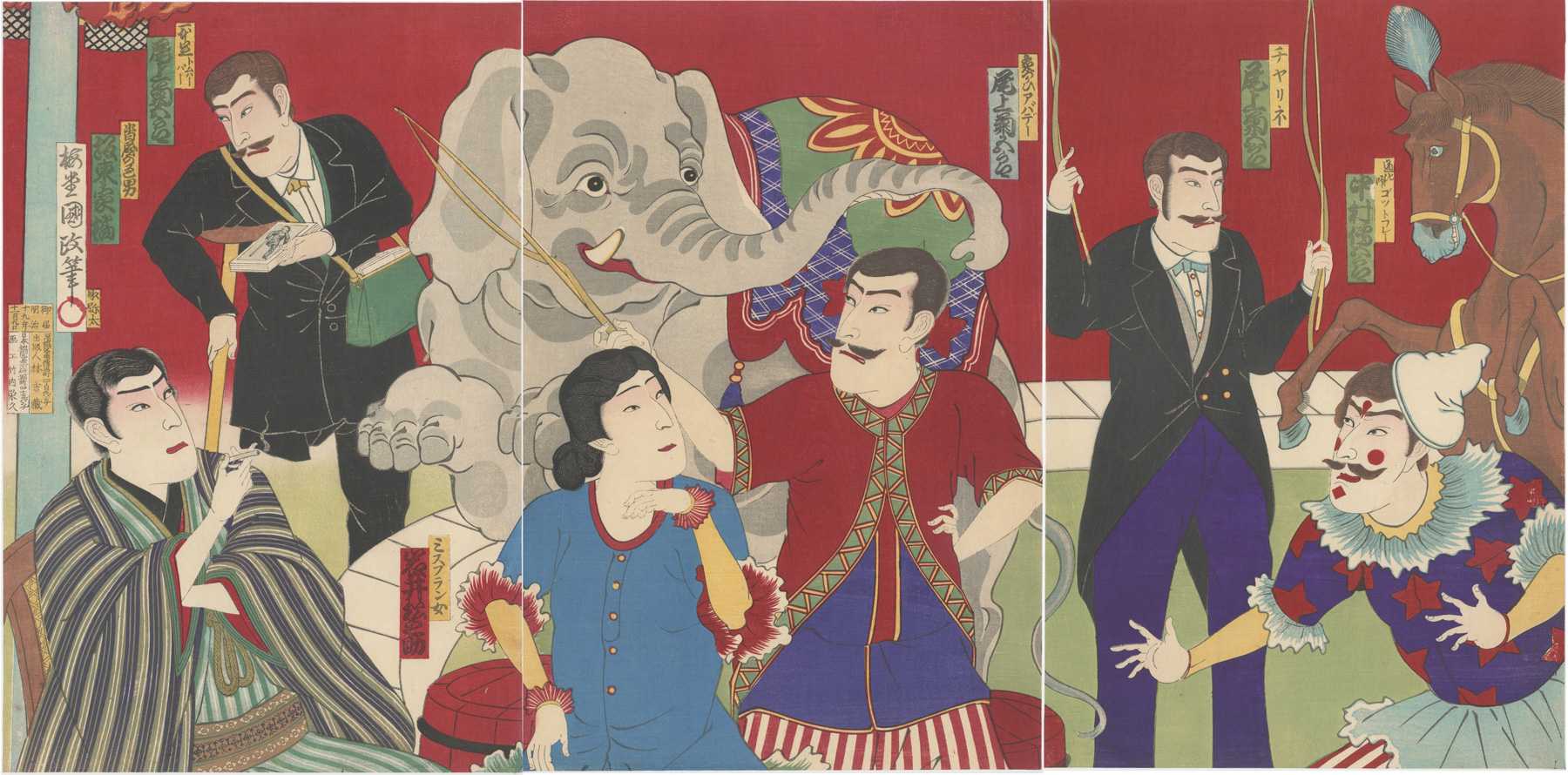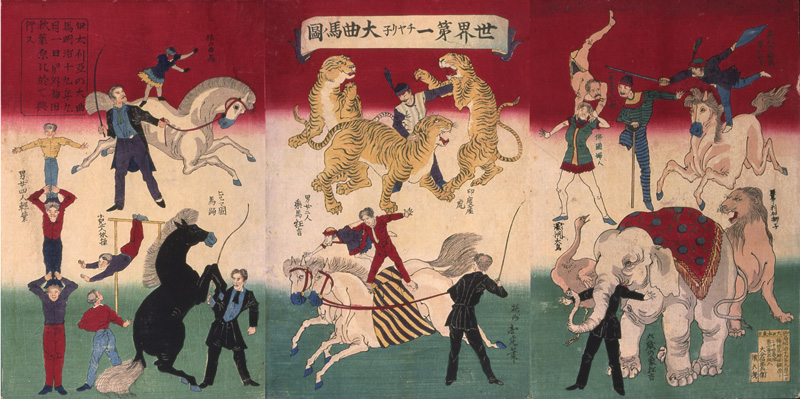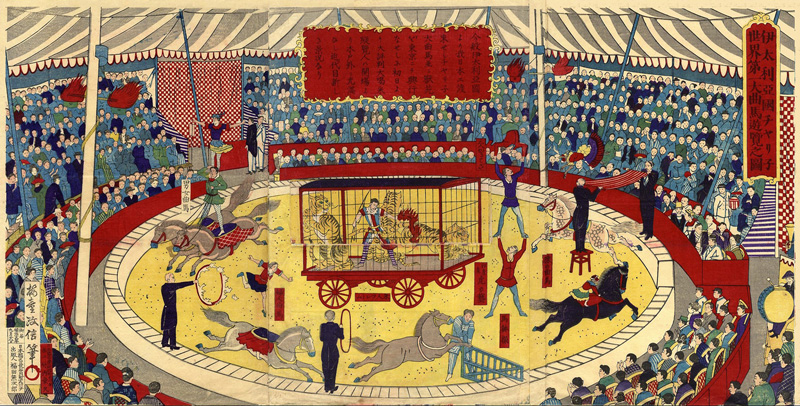A wonderful tour de force of animals and actors playing circus performers, promoting Kawatake Mokuami's kabuki play Narihibiku Chiarini no kyokuba based upon the visit of Giuseppe Chiarini's Royal Italian Circus to Japan in the summer of 1886. This type of play, written shortly after the events it depicts, was known as ichiyazuke kyōgen (overnight pickle play.)
The star of the play was Onoe Kikugorō V, playing three roles. The actors pictured in the print from right to left are:
Nakamura Dengorō III* 中村 伝五郎 as Dōkeshi Gottofure (the clown Gottofure) 道化師ゴットフレー
Onoe Kikugorō V 尾上菊五郎 as Charine チャリネ
Onoe Kikugorō V 尾上菊五郎 zōtsukai abade (the elephant trainer Abadē) 象つかいアバデー
Iwai Matsunosuke IV 岩井 松之助 as Misufuranonna (Miss French women) ミスフラン女
Onoe Kikugorō V 尾上菊五郎 as Charine チャリネ
Onoe Kikugorō V 尾上菊五郎 zōtsukai abade (the elephant trainer Abadē) 象つかいアバデー
Iwai Matsunosuke IV 岩井 松之助 as Misufuranonna (Miss French women) ミスフラン女
Onoe Kikugorō V 尾上菊五郎 as Ichi-hon ashi Tomuhaba 一本足トムハーバー
The circus advertised itself as "the most colossal combination troupe in the world containing 25 Star performers and 30 Highly Trained Horses and Ponies,”1 (and, as we can see from the prints below, lions, tigers and an elephant) and was a big hit, attended by the Emperor and royalty.
"In November 1886, Chiarini and his company performed in Tokyo for the Emperor Mitsuhito and his court; it was the first time the Meiji Emperor had ever seen a circus performance, and he presented Chiarini with $5,000 in gold. The Meiji era (1868-1912) marked the opening of Japan to the West and the industrial world, and Chiarini’s visit was an event of importance: Japanese nobility, government officials, and businessmen feted the company, and the Japanese artists Yoshu Chikanobu and Masanobu Sakuradai issued wonderful prints of Chiarini’s performance...."2
Bandō Kakitsu 坂東家橘 as Kutsunoya no Irootoko (Kutsunoya the Lady-Killer) 沓屋の色男
* The Japan Arts Council and the Tokyo Metropolitan Library read the actor playing the clown as [3代目] 中村 伝五郎 Nakamura Dengorō III but The Tsubouchi Memorial Theatre Museum of Waseda University reads the actor as [6]中村伝九郎 Nakamura Denkurō VI. According to the Kabuki 21 website, Nakamura Denkurō VI did not take that name until 1919, making it unlikely he is the actor pictured in this print.
Chiarini's Royal Italian Circus
"In November 1886, Chiarini and his company performed in Tokyo for the Emperor Mitsuhito and his court; it was the first time the Meiji Emperor had ever seen a circus performance, and he presented Chiarini with $5,000 in gold. The Meiji era (1868-1912) marked the opening of Japan to the West and the industrial world, and Chiarini’s visit was an event of importance: Japanese nobility, government officials, and businessmen feted the company, and the Japanese artists Yoshu Chikanobu and Masanobu Sakuradai issued wonderful prints of Chiarini’s performance...."2
[Sekai Dai ichi Chiyari ko Dai Kyokuba no zu]
Published by: Okura Shirobei, 03 September 1886.
Published by: Okura Shirobei, 03 September 1886.
Utagawa (aka. Baido) Masanobu , Chiarini's Royal Italian Circus in Japan
This print is particularly interesting for its precise and detailed rendition, and in that its center section has a small booklet glued on it, which allows to change the image by flipping its pages, and therefore to identify the acts in the show that particularly impressed Chaiarini's Japanese audiences. The main text in the center panel says: "The Chiarini equestrian troupe and wild-animal menagerie, which came to Japan from Italy, recently performed in Tokyo. From the first day on, they were extremely popular, and met with enormous applause. With crowds lined up in front of the gates, waiting to get in, it was a very modern sight." (The print is dated September 9, 1886)
1 Yokohama Burning: The Deadly 1923 Earthquake and Fire that Helped Forge the Path to World War II, Joshua Hammer, Simon and Schuster, 2006, p. 14.
2 website of Circopedia http://www.circopedia.org/Giuseppe_Chiarini
The Actors Pictured
For background on the actors pictured see their respective entries in the article The Kabuki Actor on this site.Print Details
| IHL Catalog | #1246 |
| Title (Description) | Chiarini's Astounding Circus (sometimes translated as The Resonant Circus of Chiarini) 鳴響茶利音曲馬 Narihibiku Chiarini no kyokuba |
| Artist | Utagawa Kunimasa IV (1848-1920) |
| Signature |  |
| Seal | Toshidama seal beneath signature as shown above |
| Publication Date | November 9, 1886 明治19年11月9日(御届) |
| Publisher |  [Marks pub. ref. 556; seal ref. 26-123] cartouche containing: top - date as shown above right half - publisher: 出板 人[shuppanjin] 林 吉蔵 [Tsujiokaya Bunsuke] followed by address left half - artist: 画工 [gakō] 竹内栄久 [Takenōchi Hidehisa, artist's birth name] followed by address |
| Carver |  |
| Impression | excellent |
| Colors | excellent |
| Condition | excellent - trimmed to image; unbacked |
| Genre | ukiyo-e; yakusha-e; 芝居絵 shibai-e (drama print) |
| Miscellaneous | |
| Format | vertical oban triptych |
| H x W Paper | 13 3/4 x 9 1/4 in. (34.9 x 23.5 cm) each sheet |
| Literature | |
| Collections This Print | Japan Arts Council 08031, The Tsubouchi Memorial Theatre Museum of Waseda University 101-7354, 7355, 7356 and 101-7402, 7403, 7404; Tokyo Metropolitan Library M648-013 |




